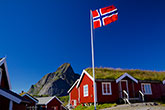Opening the LNG door
Currently there is no competitive gas market in the Baltic states and Finland. Interlinks between the countries are weak and consequently energy security level is low on the regional scale. However, some major infrastructure projects are about to change this. One of them is an LNG import terminal at Klaipeda port, implemented by Lithuanian state-controlled Klaipedos Nafta.
Lithuania is experiencing extreme dependency on Russia as its single supplier, and, as such, there is little competitiveness in Lithuania in the gas market.
As a result, gas prices are higher in Lithuania than anywhere else in Europe.
Accordingly, the country has chosen to open the gas market and to spur competition with the expectation of reduced gas prices or at least the opportunity to bargain.
It is expected that the LNG terminal at Klaipeda will help to diversify energy sources and ensure security of energy supply.
Rokas Masiulis, CEO of Klaipedos Nafta, set out the main goals to be achieved with the construction and operation of a Lithuanian LNG terminal: “By implementing this project, we believe that the gas import prices will reflect the global market price level. That’s what is expected from this terminal firstly. Also this LNG terminal is one of the key projects to ensure energy security, which creates the conditions for the emergence of the natural gas market, and brings economic benefits to the state, consumers and the company executing the project.”
FSRU vs onshore terminal
In 2010, Klaipedos Nafta began an ambitious project, which the Lithuanian government declared as strategic. At present, the construction of a floating storage and regasification unit (FSRU) is already finished, while the 450 m long jetty and 18 km long pipeline are under construction. The project is to be launched at the end of 2014. In March 20123, 170 000 m3 of LNG were contracted from Norwegian company Höegh LNG, who signed a 10-year lease agreement with the option to purchase. FSRU technology was chosen over an onshore terminal. The decision was made for several reasons, including the fact that the FSRU project requires a 50% lower capital investment, is quicker to implement by two years and contains more flexible technology.
Of the decision, Masiulis said that is was “more effective economically […] compared with investments of terminals implemented onshore, investments of a floating terminal constitute a 50% smaller amount.”
The ship-storage with a regasification unit for the terminal is designed by South Korean company Hyundai Heavy Industries Co., Ltd.
Meeting LNG demand
There will be a full third party access to the capacities of the Klaipeda LNG terminal, enabling suppliers to fill demand in domestic Lithuanian (around 3 – 3.5 billion m3/year of gas) and Baltic markets plus Finland (up to 4 billion m3/year). It is anticipated that the Baltic Connector pipeline will be completed by 2015.
Furthermore, from the first year of operations, the terminal will open capacities for small scale activities, such as ship bunkering.
“It is widely expected that the marine shipping industry will be moving towards using LNG as a ship fuel and we see our terminal very well suited geographically to meet this demand in the Baltic area”, said Masiulis. Currently the legal and regulatory basis of the LNG terminal is being developed in line with European regulatory practice. The terminal’s capacity allocation procedures are planned to begin in the first half of 2014.
Written by Klaipedos Nafta, Lithuania
Edited by Ted Monroe
Read the article online at: https://www.lngindustry.com/liquefaction/14032014/opening_the_lng_door_276/
You might also like
Gasum opens new biogas filling station in Norway
Gasum has opened its ninth bio-LNG station in Norway, located in Førde.


